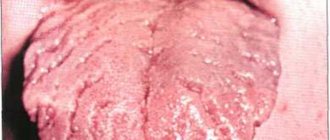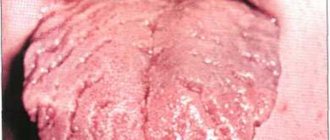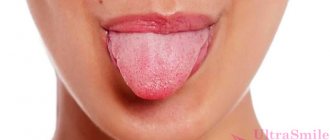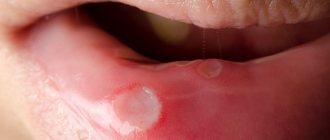The tongue is often injured. Sometimes these damages are so insignificant that we do not notice them, but these mucosal defects are the entry point for infection. Glossitis is an inflammation of the tongue that is caused by various bacteria and viruses. The disease causes a number of unpleasant symptoms that interfere with normal eating, and sometimes even interfere with talking. Glossitis is dangerous due to its complications. If measures are not taken in time, diffuse purulent inflammation may occur, spreading far beyond the oral cavity.
The disease is very common. Most often occurs in people with reduced immunity, smokers, and patients who do not pay due attention to oral hygiene.
Forms
Types of glossitis:
- deep;
- desquamative;
- diamond-shaped;
- villous;
- folded;
- Gunter's;
- syphilitic or interstitial.
The most dangerous is deep glossitis. The pathological process begins on the lower part of the tongue, and if left untreated, spreads to the floor of the oral cavity. In the case of abscess formation, the purulent process can spread to the neck, which is a life-threatening condition.
Desquamative glossitis is better known as “geographic tongue.” Irregularly shaped areas of peeling alternate with normal ones, so the tongue looks like a geographical map. This type of disease is typical for patients with chronic lesions of the digestive system, allergies, helminthic infestations, and can also occur during pregnancy.
Diamond-shaped lesions are typical for patients with chronic gastropathology. The disease is recurrent.
Villous glossitis occurs due to hypertrophy of the papillae of the tongue. This disease is one of the manifestations of a fungal infection - candidiasis, and can also occur in smokers.
The disease may be congenital. Such anomalies include a folded shape. This glossitis does not cause unpleasant symptoms and does not require special treatment.
Gunter's tongue is not an independent pathology, but one of the manifestations caused by anemia resulting from a lack of vitamin B 12 and folic acid in the body. The disease develops gradually. The mucous membrane of the tongue becomes smooth, the papillae decrease in size, and the tongue acquires a crimson hue.
Interstitial glossitis is also a secondary manifestation and is characteristic of patients with syphilis. The pathological process proceeds deeply, affecting muscle tissue. If left untreated, the muscles are replaced by connective tissue, which is an irreversible process. This form can transform into a malignant tumor.
Having seen photos of glossitis of different etiologies, you can be convinced that the clinical symptoms of this disease are varied, so only a specialist can make a differential diagnosis.
Glossitis of the tongue can be either an independent disease or one of the clinical symptoms of another pathology. For proper treatment, it is necessary to find out whether the disease is a primary inflammatory process, or arose as a result of changes in other organs and systems.
Content:
- Features of the disease
- Causes of yeast glossitis
- How it manifests itself 3.1. Other symptoms of candidiasis on the tongue
- Treatment of tongue candidiasis 4.1. Medicines used for candidiasis 4.2. Traditional methods of combating oral candidiasis
- How to eat during treatment
- How to avoid getting sick
For the full functioning of all parts of the gastrointestinal tract, various fungi and bacteria must be present in the body.
They are called opportunistic pathogens. If their quantity corresponds to the norm, the person feels well and does not experience unpleasant symptoms of the disease. But under the influence of negative external or internal factors, bacteria and fungi can begin to actively multiply. Then their activity becomes abnormal - a disease of the oral cavity or stomach or intestines is diagnosed. It is in this scenario that candidiasis develops on the tongue, throat and cheeks. Let's look at how to treat it and what measures to take to avoid relapse after recovery.
Causes of glossitis
Glossitis occurs under the influence of provoking factors. The most common of these is damage to the mucosa. Damage can occur due to the consumption of hard, spicy, hot foods. Often the tongue is injured by crowns, tooth fragments, braces or improperly made removable dentures. For infection to penetrate, a microscopic defect is sufficient, which does not cause discomfort and is visually invisible.
The source of infection in the oral cavity increases the likelihood of inflammation during injury. These include carious teeth, gum inflammation, stomatitis, and chronic tonsillitis. Failure to comply with hygiene rules, using someone else's utensils, toothbrushes, and dirty hands while eating increase the risk of infection entering the oral cavity. Children who can put dirty hands and foreign objects into their mouths are at particular risk.
Smoking and alcohol reduce local immunity and make the mucous membrane more vulnerable. In this group of patients, glossitis occurs more often than in other people.
Constant exposure to chemicals that destroy the mucous membrane eventually leads to chronic inflammation. Glossitis can even be caused by poor-quality toothpaste or mouthwash.
Dysbacteriosis, carriage of the herpes virus, reduced immunity are predisposing factors in the occurrence of glossitis.
Features of the disease
With candidiasis, there is an active spread of fungi of the genus Candida. Most often it is Candida albicans. To identify the pathogen, doctors carry out laboratory diagnostics - microscopic and bacteriological examination of the mucous membranes of the mouth, scraping plaque from the tongue.
Oral candidiasis is usually classified into two types:
- Yeast stomatitis. Affects the cheeks, gums, and palate. The tissues become covered with a characteristic white coating that cannot be easily removed.
- Yeast glossitis. The source of infection is the tongue. His back is affected. Small deep grooves are formed on its surface, in which whitish masses are deposited.
Tongue thrush always has clear clinical symptoms. It leads to swelling and inflammation of the tissues, causing severe pain. It gets to the point that the patient cannot chew food or even drink normally. The situation is aggravated by bad breath, which cannot be masked in any way.
Clinical manifestations
The first thing those suffering from glossitis encounter is pain, burning, and severe discomfort in the oral cavity. Over time, the intensity of these manifestations increases, making it difficult to eat food. Taste sensations are dulled and may be completely absent. Some patients have a phenomenon called perverted taste.
The tongue swells, which causes severe discomfort. The patient's speech is impaired, any movements of the tongue bring pain. Hyperthermia and deterioration in general health are possible.
Upon examination, you can reveal an enlargement of the tongue, a change in its color to a brighter one, up to crimson. Ulcers, blisters, spots, erosions, plaque, and lesions with altered epithelial structure may appear on the mucous membrane.
The most dangerous complication of glossitis is phlegmon. A focus of purulent inflammation is formed, which rapidly spreads to the chin and neck. Soft tissues are destroyed. Such patients require emergency medical care.
Diagnosis and treatment methods for glossitis
In most cases, the basis for diagnosis is the patient’s complaints and visual examination of the oral cavity.
When visiting a doctor, be sure to indicate when the pathological manifestations appeared and what they are associated with. If any dental treatment was performed, be sure to mention it. It is better to seek medical help at the first signs of illness. Avoid taking any medications, especially antibiotics. This may make diagnosis difficult and reduce the effectiveness of subsequent therapy.
To determine the cause of glossitis, additional diagnostic methods are used: examination of scrapings from the mucous membrane under a microscope, ELISA, PCR. These methods make it possible to determine what pathogen caused the disease, as well as to confirm or exclude syphilitic glossitis.
Determining the causative agent of the disease is the basis for successful treatment. The emphasis is on etiotropic therapy, that is, eliminating the cause of the disease. If glossitis is bacterial in nature, properly selected antibiotics will give an excellent result, but these drugs are completely useless for viral or candidal glossitis. For fungal infections, antimycotic drugs are prescribed; for viral infections, antiviral and immunomodulators are prescribed. If the cause of glossitis is anemia, treatment of the underlying disease is necessary. Special tactics are necessary for the pathological process caused by Treponema pallidum. A dermatovenerologist must be involved in the treatment of syphilitic glossitis.
An integral part of glossitis treatment is diet. In the acute period, eating food causes serious difficulties for patients, so porridges, purees, and pureed soups are recommended. Food should not be cold or hot. Solid foods, spicy, salty, sour are excluded. This avoids irritation of the mucous membrane, which minimizes discomfort and speeds up the healing process.
In some patients, the pain syndrome is significant. In such a situation, unpleasant sensations can be relieved with the help of applications with anesthetics. To moisturize excessively dry mucous membranes, products containing glycerin are used.
Local therapy includes removing plaque from the tongue and treating with antiseptic solutions. Substances such as chlorhexidine, furacilin, and potassium permanganate are widely used. To speed up the recovery of the mucous membrane, vitamin A is used topically.
Systemic antibiotics and antiviral drugs are prescribed according to indications. This tactic is used in severe cases. With a mild clinical course of glossitis, a positive result can be achieved with local treatment.
In severe cases, swelling of the tongue can be significant and make breathing difficult. In such situations, it is necessary to take glucocorticosteroids. More often they are used in the form of ointments.
During treatment you need to give up smoking and alcohol. These substances irritate the mucous membrane and prevent its regeneration.
Some patients with glossitis have keratinized areas on the tongue. Such changes cannot be treated conservatively and can only be removed surgically.
If you consult a dentist in a timely manner and follow all his recommendations, the outcome of the disease will be favorable. Glossitis responds well to treatment if its cause is determined and targeted. If the disease is not treated, it can be complicated by an abscess or phlegmon. These conditions require surgical treatment and long-term antibiotic therapy, so it is better to start treatment at the initial stage.
CHRONIC HYPERPLASIA OF FILIVID PAPILLAS
Chronic hyperplasia of filiform papillae is characterized by growth in area and increase in size of filiform papillae. That is, hypertrophy of the filiform papillae occurs.
Etiology of chronic hyperplasia of filiform papillae
The etiology of chronic hyperplasia of filiform papillae is not fully understood. Microbiological research was important, but no specific pathogens were found. Commonly encountered leptotrichia and saprophytes were found.
Scientists have identified predisposing factors to the occurrence of chronic hyperplasia of filiform papillae:
- Violation of metabolic processes;
- Alcohol;
- Smoking;
- Taking medications;
- Changes in the acid-base balance of oral fluid;
- Gastrointestinal diseases;
- Infections;
- Hypo-, vitamin deficiencies.
- Males;
- Middle or old age.
Complaints in chronic hyperplasia of filiform papillae
Complaints in chronic hyperplasia of filiform papillae may be absent. Only subjectively can the patient note the sensation of a foreign body on the back of the tongue, an unusual appearance of the tongue, the appearance of a gag reflex when chewing, swallowing food, or when talking. Itching and burning, spreading to the palate.
Clinic of chronic hyperplasia of filiform papillae
The clinic of chronic hyperplasia of filiform papillae is characterized by elongation and thickening of the filiform papillae on the back of the tongue (up to 2-3 mm); the keratinizing cells covering the back of the tongue have a color from dark brown to black. The area with hyperplasia most often has a triangular shape. The lateral and anterior surfaces of the tongue are free from hyperplasia. It was assumed that such a dark color is formed from iron compounds coming from food and the work of microflora.
Treatment of chronic hyperplasia of filiform papillae
Treatment of chronic hyperplasia of filiform papillae is complex. Consists of both general and local events.
- General treatment of chronic hyperplasia of filiform papillae:
- Treatment of autonomic pathology;
- Sanitation of the oral cavity, professional hygiene;
- Tranquilizers, sedatives, psychotherapy as needed;
- Calcium pantothenate;
- Multivitamins with microelements;
- Desensitization therapy;
- If candidiasis is present, antifungal therapy can be prescribed;
- Local treatment of chronic hyperplasia of filiform papillae involves the use of keratoplasty, strict twice-daily oral hygiene and complete cessation of smoking.
Prevention
Glossitis is easier to prevent than to treat. In order to avoid this unpleasant disease you need to follow simple rules.
The first is oral hygiene. This principle applies to both children and adults. If you wash your hands before eating, brush your teeth regularly, do not use someone else’s toothbrushes, and regularly sanitize your mouth, then the risk of developing tongue inflammation is minimal.
Try to avoid damaging the mucous membrane. Avoid eating hard foods that can damage your tongue, such as chips. Hot foods also cause epithelial defects. Spicy foods have an irritating effect. Abuse of them significantly worsens the condition of the tongue mucosa and increases the risk of infection.
Nicotine not only irritates the mucous membrane, but also impairs microcirculation, which reduces the resistance of the epithelium to the effects of infectious agents. Inflammatory diseases of the oral cavity are more common in smokers than in patients who are not adherents of this addiction. Strong alcoholic drinks also have a negative effect on the mucous membranes.
If you have symptoms of glossitis, do not self-medicate, contact a dental clinic. A competent specialist will determine the cause of the disease and prescribe treatment that will help quickly get rid of unpleasant symptoms. Remember, if glossitis is not treated, the disease can lead to serious complications and irreversible consequences.
FOLDED TONGUE
Most often, a folded tongue is a sign of an abnormal development of the tongue, and this form of glossitis manifests itself in childhood. The synonymous name for the folded tongue is “scrotal tongue”, this is due to the similarity of the tongue to the skin of the scrotum. Most often, a folded tongue is accompanied by an enlargement of the tongue - macroglossia, which makes it not only large, but also prominent. With a pronounced longitudinal groove, the tongue is called “slit-like”. Because of this anatomy (the presence of deep grooves), excellent conditions are created for the development of pathogenic microflora, especially for fungi of the genus Candida. Therefore, in such patients the risk of candidiasis increases. Treatment for a folded tongue is not required. Only the patient should be well motivated to perform thorough oral hygiene and professional hygiene at the dentist.
BE CAREFUL NOT ONLY OF YOUR PATIENTS, BUT ALSO OF YOURSELF. LOVE TO ALL! WITH:
THANK YOU FOR READING ^_^
The article was written by N. Shidlovskaya specifically for the OHI-S.COM website. Please, when copying material, do not forget to provide a link to the current page.











